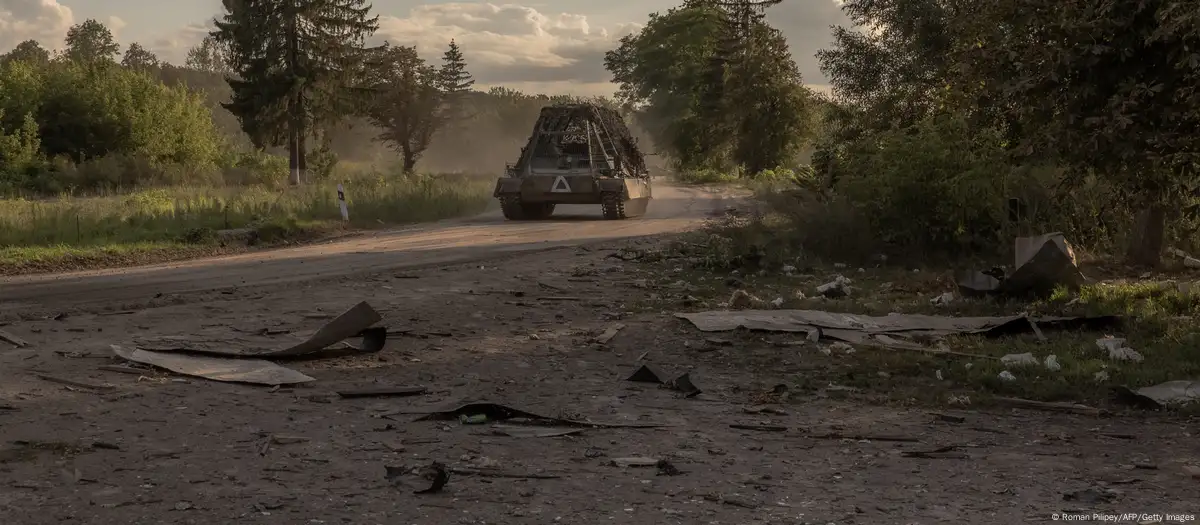How far will Ukraine advance in Russia's Kursk region?
For the first time since the start of Russia's invasion, Ukraine has sent troops to capture a major part of Russian territory. Western experts say the Kursk incursion is a sign of a new strategy.

Ukraine may have taken a "first step" toward a strategy change in its defense against the Russian invasion. That's how Jen Spindel, assistant professor at the University of New Hampshire in the US, described the recent developments in western Russia's Kursk region.
"Ukraine cannot continue to fight this war in the same way it has been for the past two years. It just simply doesn't have the manpower or weapon stores to do so," said Spindel, a foreign policy and security expert.
"Russia is much bigger, and has a larger military, and Ukraine can't continue fighting Russia on equal footing," she said. "It needs to embrace much more of an asymmetric style war, and bring the conflict into Russia, if it wants to have hope of staying in the fight."
Spindel said this means that instead of confronting the Russian army, in many respects superior, on the open battlefield, Ukraine would need to employ tactics more appropriate to the strengths and armaments available to Ukrainian forces — exactly what appears to be happening in Kursk.
"I see this operation in Russia as Ukraine's attempt to slightly shift its strategy," she told DW. "It is showing that Russian territory is no longer off-limits, and that Ukraine will attack Russian territory to force Russia to divert its forces from bombing and causing destruction in Ukraine."
Why is Ukraine sending troops into Kursk?
In the week since the start of the Ukrainian advance, Kyiv has kept mostly quiet about its plans.
President Volodymyr Zelensky has so far only spoken of "actions to push the war out into the aggressor's territory," while a high-ranking Ukrainian military officer told the AFP news agency over the weekend that "thousands" of Ukrainian soldiers were involved. The aim was to "overextend" Russian forces and "destabilize" the situation.
On Monday, Ukraine's top military commander, General Oleksandr Syrskyi spoke for the first time about the "offensive operation in the Kursk region." Ukraine, he said at a briefing, now controls around 1,000 square kilometers (roughly 400 square miles) of Russian territory.
Speaking at a meeting with top Russian defense officials on Monday, Russian President Vladimir Putin said the Ukrainian offensive was an attempt by Kyiv to gain the upper hand in possible future talks to end the war. But, he added, the Ukrainian plan would not succeed, with Russia's primary goal being to "squeeze out, drive the enemy out of our territories."
How far have Ukrainian troops moved into Russia?
According to Russian sources, Ukrainian troops advanced into the Kursk region on August 6, quickly moving some 10 kilometers (6 miles) past the border. A week later, media reports suggest the Ukrainians have advanced some 30 kilometers into Russian territory, and have occupied several small villages. The front line remains in flux.
Russia's Defense Ministry has claimed to have halted the Ukrainian advance, saying that fighting is now restricted to two lesser districts on the border. Moscow is especially concerned about the safety of the Kursk nuclear power plant, although according to Russian reports, the fighting is still at least 30 kilometers away from that area.
This offensive is the first major advance by official Ukrainian troops into Russian territory since the start of Russia's invasion in February 2022. Last year, informal operations by Russian opposition units fighting for Ukraine took place in Russia's Belgorod region, further south.
'Good for morale, but insignificant in the war'
The Ukrainian advance was "the result of careful planning" on the part of Kyiv, and a "total failure of Russian reconnaissance work," according to Austrian military historian Colonel Markus Reisner.
He credited Kyiv with a "clear propaganda victory," because everyone now is focused on Kursk and not on Ukraine's Donbas region further south, where the Russians are slowly advancing toward cities like Chasiv Yar and Pokrovsk. If Ukraine is able to maintain its control in the Kursk region, he said, it would force Russia to regroup — reducing pressure in Donbas.
Gustav Gressel, a Berlin-based military affairs expert at the European Council on Foreign Relations, took a more skeptical view of the situation in the first days of Ukraine's offensive, calling it "good for morale, but insignificant in the war."
"There have been no signs that Russia is moving troops from the east to stop the Ukrainian advance," he told DW. However, in recent days there have been unconfirmed reports that Russia has moved some troops from northeast Ukraine to Kursk.
"Russia is the main beneficiary of an extension of the front line into Russian territory, as it further overstretches Ukraine's armed forces," said Gressel.
However, experts believe Ukraine could also be pursuing other goals with its advance toward Kursk. For example — as Putin suspects — to improve its negotiating position with Russia, or to boost the morale of Ukrainian troops "who have 'only' been defending their positions in a grueling war of attrition for that last year-and-a-half," said German journalist and Ukraine expert Winfried Schneider-Deters.
For the Ukrainians, he said, this offensive — especially on enemy territory — is likely to be of considerable importance
"It is possible the Ukrainian leadership wants to demonstrate to Russia, but above all to the West, that Ukraine is not at the end of its tether," said Schneider-Deters. "[Kyiv wants to show] that it's still able to win the war — with further shipments of Western weapons."
US reacts cautiously to Kursk offensive
The offensive marks a "turning point" and is "long overdue," said Schneider-Deters. Until now, the West, led by the US, has prevented Ukraine from moving onto Russian territory out of concern that the war would spread further, he added, saying it was "right" for Ukraine to now ignore these restraints.
The US, Germany and other Western partners had long banned Ukraine from using their weapons to directly attack Russia territory. Ukrainian troops first got the go-ahead in May, following the renewed Russian offensive on Kharkiv — though the authorization remains limited to the immediate border area. Long-range ballistic missiles, like the ATACMS supplied by Washington, may still only be fired over occupied Ukrainian territory.
To date, the US has reacted cautiously to Ukraine's Kursk offensive, though Spindel assumes there have been many high-level phone calls between Kyiv and Washington to de-escalate the situation.
How much further will Ukraine advance?
Spindel believes that in order to achieve its goals, Ukraine doesn't need to advance "particularly far" into Russian territory.
"I don't think anyone wants to see this escalate to a conflict where Ukraine is sending troops toward Moscow, or flying drones or planes in that direction," she said, adding that the further the Ukrainian army advances, the greater the risk that troops will be cut off from supply routes.
Spindel said the latest advances, into the areas that serve as Russia's deployment zones and where it keeps its weapons, were "significant enough to be a clear operation within Russia, but not far enough to risk a much broader escalation of the war."
Ukraine, she said, needed to maintain a balance and show consideration for its Western partners. However, she believes this incursion onto Russian territory likely won't be the last.
"My bet is that we'll see increased operations like this, but that Ukraine will try to keep them a surprise, as it did with this Kursk operation," she said. "Ukraine can't match the size of the Russian military, but it can continue to rely on surprise and superior tactics to try to keep Russia off balance."
DW







